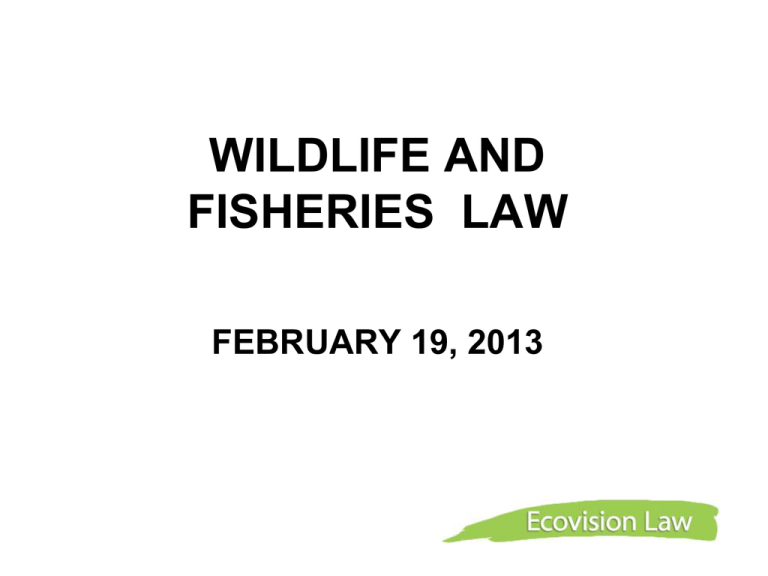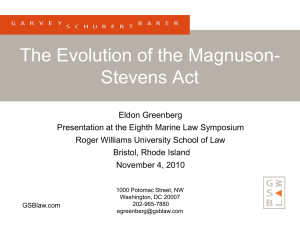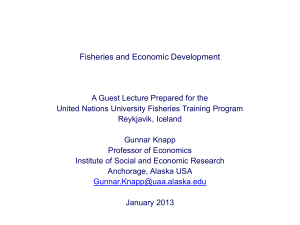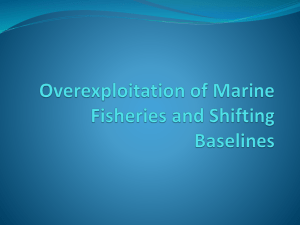February 19 Wildlife and Fisheries Law
advertisement

WILDLIFE AND FISHERIES LAW FEBRUARY 19, 2013 Overview • Development of wildlife, fisheries law • Wildlife management law (Ontario) • Migratory Birds Convention Act (Federal) • Fisheries Act (Federal) Issues • Successes and failures in managing wildife and fish populations • Algonquin wolves • Aborginal spring goose hunt • Catastrophic collapse of northern cod • Protecting fish habitat and “no net loss” Market Hunting • Unregulated hunting of wildlife for commercial purposes was major conservation issue in late 19th century • Passenger Pigeons were globally one of the most abundant birds in 19th century (3 – 5 billion); hunted to extinction by early 20th century • Bison were 60 to 100 million in western North America in mid 19th century; hunted to near extinction Market Hunting • U.S. and Canadian laws banned market hunting by early 20th century • Early U.S. national parks (Yellowstone had a small bison herd) also a response to market hunting • Migratory Birds Convention, Fish and Wildlife Conservation Act response to market hunting Migratory Birds Convention 1916 • Signed by U.S. and U.K. to protect North American migratory birds from overhunting and habitat loss • Migratory Birds Convention Act 1917 • Market hunting (including spring hunting) was of primary concern • Hunting of non-game birds banned • Nest destruction, egg taking prohibited • Eskimos and Indians authorized to hunt murres, puffins, auks Migratory Birds Convention 1916 • Set out a closed season for migratory birds from March 11 to August 31 • Didn’t take into consideration aboriginal spring subsistence hunt in northern Canada • Critical source of food in spring • Geese and ducks arrived and departed during closed season Migratory Birds Convention 1916 • Policy of non-enforcement of Convention, MBCA, formalized in 1971 • Challenge to government of Canada • Needed to convince U.S. to amend Convention (Senate ratification) • Canadian federal government no constitutional authority with respect to migratory birds except via Convention Migratory Birds Convention 1916 • Protocol to Convention 1995 recognized aboriginal hunting rights • Authorized aboriginal people to hunt migratory birds and gather eggs throughout year • Sale of birds and eggs limited to aboriginal communities Fish and Wildlife Conservation Act (Ontario) • Regulates hunting, trapping and fishing of vertebrate (mammals, birds, reptiles, amphibians, fish) and certain invertebrates (butterflies) • No hunting, trapping of game mammals, game birds; furbearing mammals etc. without licence s.6.(1) • No hunting of “specially protected wildlife” s. 5.(1) Fish and Wildlife Conservation Act (Ontario) • No buying or selling of game wildlife or specially protected wildlife without licence s. 48.(1) • No keeping of live game wildlife or specially protected wildlife without licence s.40.(1) • No trespassing for hunting on premises marked pursuant to Trespass to Property Act Fish and Wildlife Conservation Act (Ontario) • No buying or selling of game wildlife or specially protected wildlife without licence s. 48.(1) • No keeping of live game wildlife or specially protected wildlife without licence s.40.(1) • No trespassing for hunting on premises marked pursuant to Trespass to Property Act Fish and Wildlife Conservation Act (Ontario) • No hunting, trapping in a provincial park or provincial game preserve s.9.(1) • Any person can harass or kill wildlife who on reasonable grounds believes it is damaging or about to damage its property on his/her land s.31.(1) • A farmer can hunt or trap wildlife (including wolves) on his/her property without a licence s. 6.(3) Eastern (Algonquin) Wolves • Once occupied a range throughout eastern North America north to boreal • Now mainly limited eastern Ontario/western Quebec centred on Algonquin park • Genetically distinct from grey wolf, but is interbreeding with coyote • Historically hunted/trapped outside Algonquin park Eastern (Algonquin) Wolves • In 2004, CPAWS Ottawa Valley played key role in establishing a buffer zone in all 39 townships that surround Algonquin Park • Killing of wolves and coyotes is now prohibited in these townships Fish and Wildlife Conservation Act (Ontario) • How can this Act purport to regulate fishing when inland fisheries is a federal constitutional responsibility? • Ontario Fishery Regulations are Fisheries Act regulations • Ontario Minister of Natural Resources has authority under FWCA to issue fishing licences under the Ontario Fisheries Regulations Fisheries Act: Regulation of Fishing Effort • Canada's authority over fish and fish habitat based on sea coast and inland fisheries authority under Constitution • Fisheries and Oceans Canada manages Canada's fisheries under the Fisheries Act (research, oceanography, hydrography, small craft harbours) • Regulations and Ministerial orders to mitigate the common property problem in commercial fisheries Fisheries Act Regulation of Fishing Effort • Province-specific regulations under Fisheries Act regulating type and size of gear used, vessel length, fishing times and areas, catch limits, limiting the number of licenses available to fish, marketable harvest rights (individual transferable quotas) • Fisheries minister has authority to issue orders to close fisheries (e.g., Pacific salmon runs) Collapse of the Northern Cod Fishery • Until late 1950s, cod fishery exploited by migratory seasonal fleets and resident inshore small scale fishers • Late 1950s, offshore bottom trawlers began exploiting stock, leading to large catch increase, big decline in biomass • Open fishing ended in 1970s Collapse of the Northern Cod Fishery • Licences to fish required for all fisheries by end of 1970s • One fisher could hold licences for several fisheries • Licences bought and sold although in theory were federal property • No direct control on fisher numbers • Licences restricted for non-Canadians Collapse of the Northern Cod Fishery • DFO increasing use of conservation quotas and fishing zones to limit and allocate catch in 1970s • Foreign fishing national issue by mid1970s (landings tripled to 600,000 tonnes per year) • Canada extended fishing limits to 200 nautical miles in 1977, which allowed reduction in fishing pressure • Law of the Sea EEZ Collapse of the Northern Cod Fishery • Cod stocks collapsed to low levels in late 1980s, moratorium declared 1992 • What happened? Scientific stock assessment models grossly inaccurate • Scientists that did prophesy disaster were ignored by DFO officials • Secretive DFO culture • Importance of breeding stock ignored • Canada’s trawler fleet subsidized Collapse of the Northern Cod Fishery • Minister John Crosbie delayed moratorium due to industry pressure • Uncertainty in scientists’ stock assessments used to justify high quotas • Increased regulatory efforts and scientific research failed • Over 20 years later, cod still at low levels; fundamental ecological changes • Tragedy of the Commons? • Lessons Learned? Fisheries Act – Protection of Fish Habitat • 1977 fish habitat protected under Fisheries Act based on understanding that regulating fishing effort not enough • S.35(1) prohibited harmful alteration, disruption or destruction of fish habitat • S.35.(2) provides for ministerial authorization to destroy habitat (not project itself) • If habitat destruction occurs, proponent may be guilty of offence Fisheries Act – Protection of Fish Habitat • S.35.(2) supplemented by DFO’s “No Net Loss of Fish Habitat” policy • Developers/proponents who needed to harm or destroy fish habitat were required to replace or mitigate habitat • A sustainability policy? • Prior to 2012, CEAA environmental assessments required before s.35.(2) authorization could be issued Fisheries Act – Pollution of Waters Frequented by Fish • S.36 creates offence to deposit deleterious substances into waters frequented by fish • Pollution cannot be authorized except under regulations (Metal Mining Effluent Regulations, Pulp and Paper Effluent Regulations) Bill C-38 Omnibus Budget Bill 2012 • Bill C-38 narrows s. 35 but not s. 36 • “Long-term” amendment creates prohibition against “serious harm to fish that are part of a commercial, recreational or Aboriginal fishery, or to fish that support such a fishery” • “Serious harm” is defined as “death of fish or any permanent alteration to, or destruction of, fish habitat” Bill C-38 Omnibus Budget Bill 2012 • What’s the difference? • Many alterations to fish habitat may be temporary in nature but have lasting harm to fish • Removing vegetation from spawning stream, adding sediment from road could wipe out year class of salmon Bill C-38 Omnibus Budget Bill 2012 • Expands the authorization of harm • S.142.(1) authorizes harm to fish habitat caused by certain works, undertakings, activities prescribed by regulations • S.142.(1) also provides that harm to certain Canadian fisheries waters prescribed by regulations would be exempt from s.35.(1) prohibition • Regulations exempt from regulatory review/publication process Bill C-38 Omnibus Budget Bill 2012 • Fisheries Act amendments broaden discretion to remove regulatory controls for development projects (pipelines, oil and gas projects, mines) • Provinces may not be able to fill any gaps for projects such as pipelines, rail nuclear facilities, rail lines








